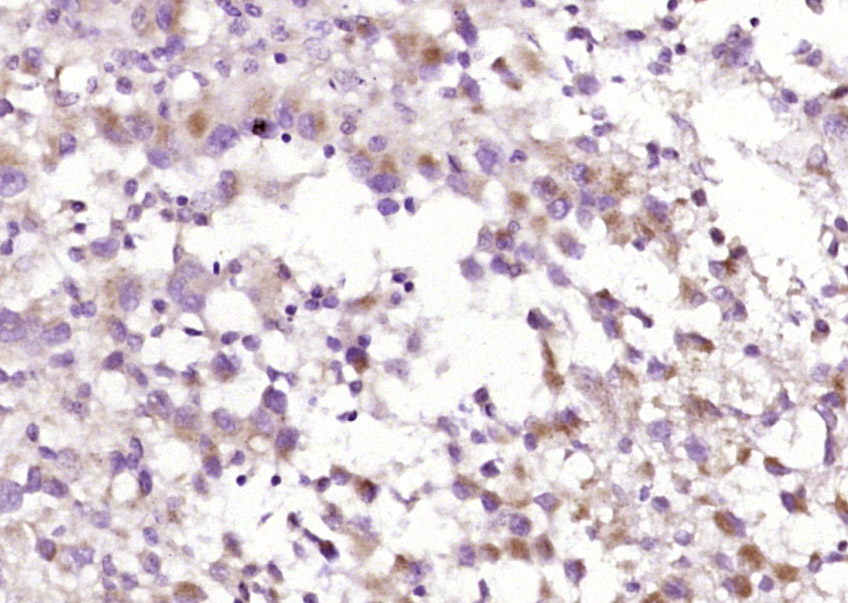
Rabbit Anti-C1QC antibody
C1Q C; C1qc; C1QC_HUMAN; C1QG; Complement C1q subcomponent subunit C; Complement component 1, q subcomponent, C chain; complement component 1, q subcomponent, gamma polypeptide; AI385742.
View History [Clear]
Details
Product Name C1QC Chinese Name 补体C1qγ链多肽抗体 Alias C1Q C; C1qc; C1QC_HUMAN; C1QG; Complement C1q subcomponent subunit C; Complement component 1, q subcomponent, C chain; complement component 1, q subcomponent, gamma polypeptide; AI385742. literatures Research Area immunology Neurobiology Cell type markers Immunogen Species Rabbit Clonality Polyclonal React Species Human, Mouse, (predicted: Rat, Dog, Horse, Rabbit, ) Applications ELISA=1:5000-10000 IHC-P=1:100-500 IHC-F=1:100-500 ICC=1:100-500 IF=1:100-500 (Paraffin sections need antigen repair)
not yet tested in other applications.
optimal dilutions/concentrations should be determined by the end user.Theoretical molecular weight 23kDa Cellular localization Secretory protein Form Liquid Concentration 1mg/ml immunogen KLH conjugated synthetic peptide derived from human C1QC: 81-180/245 Lsotype IgG Purification affinity purified by Protein A Buffer Solution 0.01M TBS(pH7.4) with 1% BSA, 0.03% Proclin300 and 50% Glycerol. Storage Shipped at 4℃. Store at -20 °C for one year. Avoid repeated freeze/thaw cycles. Attention This product as supplied is intended for research use only, not for use in human, therapeutic or diagnostic applications. PubMed PubMed Product Detail C1q, a subcomponent of the classical complement pathway, is composed of nine subunits that mediate classical complement activation and thereby play an important role in the immune response. Six of these subunits are disulfide-linked dimers of chains A and B, while three of these subunits, designated C1q-A through C1q-C, are disulfide-linked dimers of chain C. The presence of receptors for C1q on effector cells modulates its activity, which may be antibody-dependent or independent. Macrophages are the primary source of C1q, while anti-inflammatory drugs as well as cytokines differentially regulate expression of the mRNA, as well as the protein. However, its ability to modulate the interaction of platelets with collagen and immune complexes suggests C1q influences homeostasis as well as other immune activities, and perhaps thrombotic complications resulting from immune injury. Defects in C1q-A, C1q-B and C1q-C cause inactivation of the classical pathway, leading to a rare genetic disorder characterized by lupus-like symptoms.
Function:
C1q associates with the proenzymes C1r and C1s to yield C1, the first component of the serum complement system. The collagen-like regions of C1q interact with the Ca(2+)-dependent C1r(2)C1s(2) proenzyme complex, and efficient activation of C1 takes place on interaction of the globular heads of C1q with the Fc regions of IgG or IgM antibody present in immune complexes.
Subunit:
C1 is a calcium-dependent trimolecular complex of C1q, R and S in the molar ration of 1:2:2. C1q subcomponent is composed of nine subunits, six of which are disulfide-linked dimers of the A and B chains, and three of which are disulfide-linked dimers of the C chain.
Subcellular Location:
Secreted.
Post-translational modifications:
O-linked glycans consist of Glc-Gal disaccharides bound to the oxygen atom of post-translationally added hydroxyl groups.
DISEASE:
Defects in C1QC are a cause of complement component C1q deficiency (C1QD) [MIM:613652]. A rare defect resulting in C1 deficiency and impaired activation of the complement classical pathway. C1 deficiency generally leads to severe immune complex disease with features of systemic lupus erythematosus and glomerulonephritis.
Similarity:
Contains 1 C1q domain.
Contains 1 collagen-like domain.
SWISS:
P02747
Gene ID:
714
Database links:Entrez Gene: 714 Human
Entrez Gene: 12262 Mouse
Omim: 120575 Human
SwissProt: P02747 Human
SwissProt: Q02105 Mouse
Unigene: 467753 Human
Unigene: 439732 Mouse
Unigene: 2393 Rat
Product Picture
Bought notes(bought amounts latest0)
No one bought this product
User Comment(Total0User Comment Num)
- No comment




 +86 571 56623320
+86 571 56623320
 +86 18668110335
+86 18668110335

